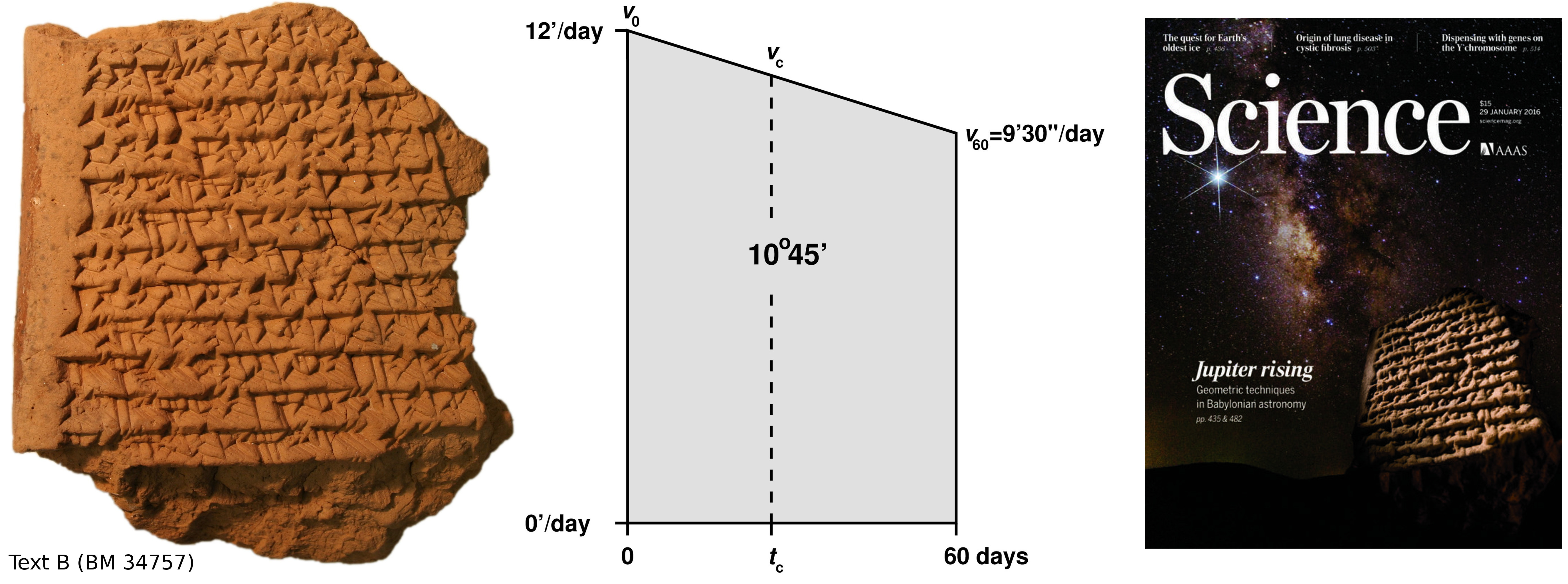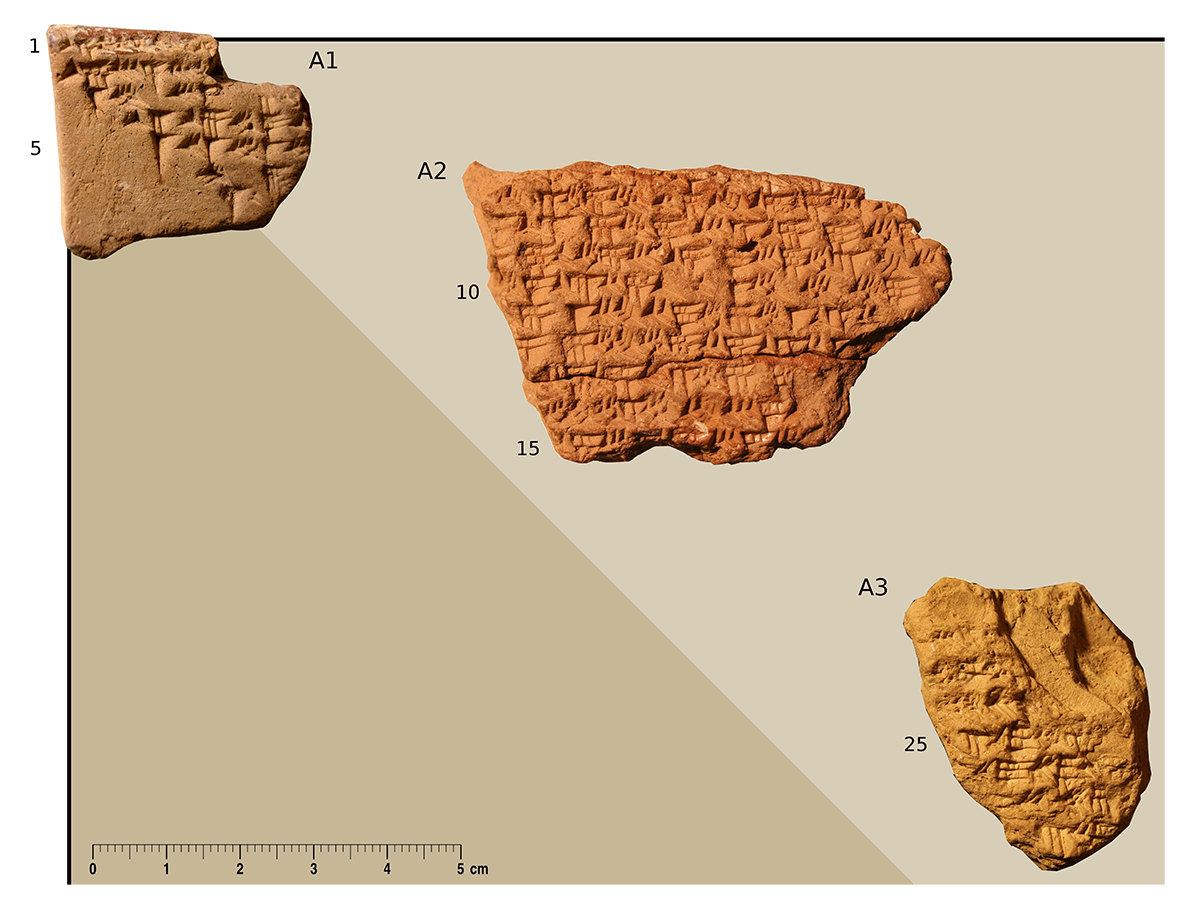In this project various operational, mathematical, astronomical, conceptual and theoretical aspects of Babylonian mathematical astronomy were investigated. Babylonian mathematical astronomy comprises about 440 cuneiform tablets and fragments from the Achaemenid, Seleucid and Parthian eras of the Late Babylonian period (400-50 BCE). The tablets were found in Babylon and Uruk, two main centers of Babylonian science.
Research
In mathematical astronomy the zodiac is used for computing positions of the planets, the moon and the sun. The tablets include ca. 340 tabular texts with computed times, positions and other quantities and ca. 110 procedure texts with corresponding verbal instructions. Since the procedure texts have already been studied in great detail (Ossendrijver 2012, Babylonian Mathematical Astronomy: Procedure Texts), this project focussed on the tabular texts and their relation to the procedure texts and other mathematical texts. Regular visits to cuneiform collections holding Babylonian astronomical and mathematical tablets, such as the British Museum (London) and the Vorderasiatisches Museum (Berlin), were an essential part of the project. The main goal was to publish a new edition of the tabular texts, which is under preparation (Ossendrijver, upcoming, Babylonian Mathematical Astronomy. Tabular Texts, Springer). Several smaller projects dedicated to aspects of Babylonian astronomy and the wider mathematical corpus are also pursued.
Geometrical methods in Babylonian astronomy
Along with the tabular texts, the procedure texts of mathematical astronomy continued to be a topic of research in project (D-1-1). A discovery made on tablets from the British Museum (London) was published in the journal Science:
Four procedure texts, most likely written in Babylon between 350 and 50 BCE, reveal that Babylonian astronomers computed the distance traveled by Jupiter from the area of a figure representing a graph of its changing daily displacement (velocity) against time. Historians of science thus far thought that this type of geometrical representation and computation of motion, well known to modern students of physics, was invented in the fourteenth century AD. As it now appears, Babylonian astronomers already came up with a very similar idea.

Left: Cuneiform tablet with calculations involving a trapezoid. Right: The distance travelled by Jupiter after 60 days, 10º45′, is computed as the area of the trapezoid. The trapezoid is then divided into two smaller ones of equal area in order to find the time in which Jupiter covers half this distance (M. Ossendrijver, 2016, Science 35, 482-484). Photo and illustration: Trustees of the British Museum/Mathieu Ossendrijver
Methods and problems of translation and interpretation in Babylonian astronomy
Babylonian astronomical texts present us with particular problems of translation and interpretation. In 2014-2016 Mathieu Ossendrijver was a member of two research networks dedicated to these topics: “Mathematical Sciences in the Ancient World” (SAW), Karine Chemla, ERC/CNRS/ Université Paris Diderot (regular short visits and longer visit February-March 2015) and “Writings of Early Scholars”, three workshops (2012-2014) organized by Annette Warner-Imhausen (Universität Frankfurt) and Tanja Pommerening (Universität Mainz). The methods of translation and interpretation that underlie past and present editions of Babylonian astronomical texts were investigated and assessed. In collaboration with the other participants of the “Writings of Early Scholars” workshops, some methodological guidelines for translating and editing ancient scholarly texts were developed and presented in a publication:
Algorithms, procedures and systems of texts in Babylonian mathematical astronomy
Various operational, theoretical, mathematical and astronomical aspects of the procedure texts and the tabular texts are investigated. The corpus of mathematical astronomy is approached as a structured system of interrelated texts, which are themselves also structured hierarchically at various levels. Beyond that, individual algorithms, attested in tabular texts, in procedure texts, or in both, are reconstructed on the basis of newly discovered tablets or by reanalysing previously known tablets (Ossendrijver 2015a, Ossendrijver 2015b). Part of this research was conducted in the framework of regular workshops and meetings at SAW/CNRS, Université Paris Diderot.
Late Babylonian mathematics and its relation to mathematical astronomy
The main collection of the British Museum holding Babylonian astronomical tablets, the so-called Babylon-Sippar collection, also contains a relatively small number of mathematical tablets from the Late Babylonian period. During several visits to the British Museum and the Vorderasiatisches Museum previously unknown or badly understood Late Babylonian mathematical tablets were investigated. They were most likely written by the same scholarly priests connected to Babylon’s main temple, Esagila, as the astronomical tablets. They shed significant new light on the mathematical practices pursued by these scholars.

This tablet with descending powers of 9 in sexagesimal notation belongs to a newly discovered class of mathematical tables from the Late Babylonian period (Ossendrijver, 2014, Journal of Cuneiform Studies 66, 149-165). Photo: Trustees of the British Museum/Mathieu Ossendrijver.
Beyond the presentation of results in several publications, international conferences and workshops the project´s work has been discussed in the media.
